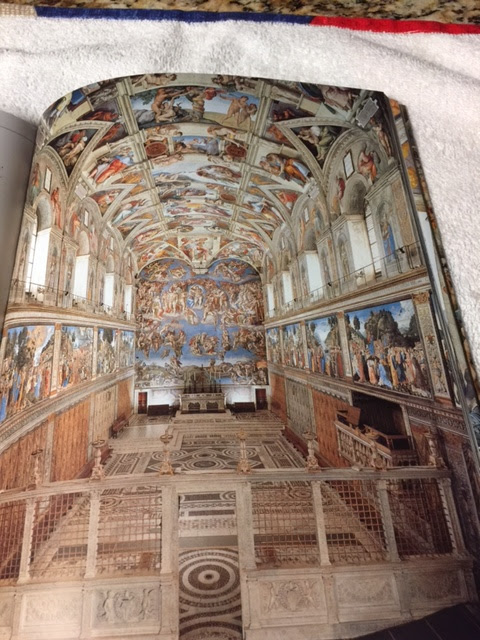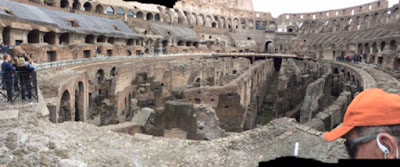POMPEII
This was Friday, the day on
our own. We decided a couple of weeks
before leaving that we’d spend this day exploring Pompeii. The tour we booked (online) explained that we
would have a 2.5-3 hour drive to before
we got there. It was a pretty full bus
and we were assigned a particular guide who shepherded us around and kept track
of us. Our guide was Manuele and he gave
us information about Pompeii and general Italian stuff til we got there. He had a strong deep voice and N had no
trouble hearing and understanding him.
However, the other guide spoke about half the time. Enriqueta, on the other hand, had a soft, not
easily understood voice, so half the info was more difficult to
understand.
We heard a really long story
of the Monastery Monte Cassino, which
was one of the places the Allies bombed in WWII. The monastery was built by St. Benedict
over a Roman ruin and it was expanded numerous times. The site was damaged twice by earthquakes,
was burned at one time and sacked by vandals another time. Benedict began a library (of scrolls) there
in the 6th century AD. The
library grew to 11,000 items (both ancient scrolls and books) by the beginning
of WW II. General Clark was the person
who decided what and where and when to bomb.
This was an excellent refuge for German soldiers, so the order was given
to bomb the monastery, but General Clark hesitated for awhile. It was discovered later that word had reached
the Abbot who removed the entire library before the bombing began and the
entire library was saved, although the buildings were severely damaged.
She talked of the evil deeds
of Mussolini and her (the Italian
people’s) gratitude in the rebuilding of the monastery and the country after
the war by way of the Marshall Plan.
We received a long discourse
(we were on the bus for 3 hours) about wines,-- the best in ancient times, how
they made it by boiling, etc.
She explained why Italians
(and many other nationalities) drive/walk on the left side of the street. Had to do with having the sword arm (right)
ready to fight/protect. This was changed
in countries Napoleon conquered when he decreed that they must use the other
side of the road. Sounds a little
strange/suspicious, but that is what was relayed to me on our long ride.
Vesuvius erupted on Aug 24, 79 AD (actual date, probably not
correct, but does it matter?) No lava
spewed—the town was inundated by scalding ash and pumice which was thrown in the
air and went south because that is the way the wind was blowing. There were earthquakes days before the
eruption and the poor left the city to find safety. The wealthy stayed to protect their property
and stuff and died. The inhabitants were
killed by toxic gasses and hot pumice.
In 30 minutes the entire town was covered to over the highest
walls. How do we know about this? A young 17 year old named Pliny the Younger- (his uncle was Pliny
the Elder) who was in the Gulf of Naples, saw from a distance what was happening
and wrote it all down.. He described
that the day turned dark. This is (and
was) the most densely populated volcanic area in the world. The last eruption was recorded in 1944 and
another was expected in 20-30 years.
They are well beyond the time it should have occurred.
As we walked into the
restored (kinda’) city of Pompeii, we were assigned to a local guide name
Willie and were given radios to hear what he was saying. The group we were in included 3 young men
(10, 12, 14 yrs old) and this will be relevant later. We saw the area where the gladiators trained
and also saw the theatre which seats 5,000
We saw shops and
residences—shops had a groove in the threshold for sliding (and locking) a
door, and the residences had a marble threshold. One house we explored included bedrooms,
kitchen, lounging area, atrium for
bringing in light and capturing rainwater.
The streets were intentionally not level with a groove down the middle for water to flow away.
The streets were intentionally not level with a groove down the middle for water to flow away.
The bodies of the people who
were trapped and died in this disaster decomposed over the years leaving a mold
of their bodies in the hardened ash.
Archeologists carefully excavated these “molds” and poured plaster into
them to show how the people who died looked.
The town had running water
for public use and for a few private
houses. The water was moved via lead
pipes (which could cause serious mental problems) but the water had a great
amount of calcium, which coated the pipes, saving the population from lead
poisoning. Some of the pipes are visible
in the walls.
 |
| lead water pipe in wall |
Our guide seemed sensitive that the 3 boy’s parents might not want them to get a full account of the brothel in the town. He delicately described the rooms and the need for companionship for travelers. This was all quite legal in Pompeii. Some of the adults who may not have been listening to Willie’s discourse might have been a bit confused. The signs leading to the brothel were phallic images carved into the marble of the street—pointing the way to the brothel named Lupanare. Figure that out, those who know some Latin.
We saw a collection area for
urine—used to dye cloth.
Pompeii’s ruins were not
“found” until the 19th century because people were looking for it in
the wrong place
Pompeii is not completely
excavated or restored to leave something
for posterity to see what things were like when it was originally found—it is
also a very expensive undertaking to unearth and protect what has been done.















































